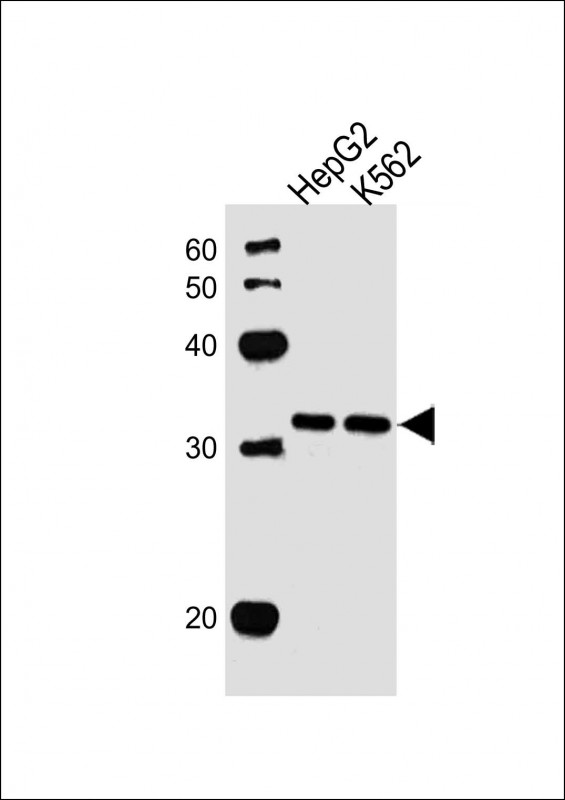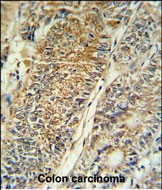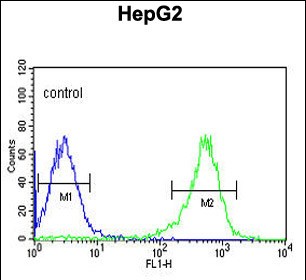PYCR1 Antibody (C-term)
Affinity Purified Rabbit Polyclonal Antibody (Pab)
- SPECIFICATION
- CITATIONS
- PROTOCOLS
- BACKGROUND

Application
| FC, IHC-P, WB |
|---|---|
| Primary Accession | P32322 |
| Reactivity | Human |
| Host | Rabbit |
| Clonality | Polyclonal |
| Calculated MW | H=33,36 KDa |
| Isotype | Rabbit IgG |
| Antigen Source | HUMAN |
| Gene ID | 5831 |
|---|---|
| Antigen Region | 291-319 aa |
| Other Names | Pyrroline-5-carboxylate reductase 1, mitochondrial, P5C reductase 1, P5CR 1, PYCR1 |
| Dilution | FC~~1:10~50 IHC-P~~1:50~100 WB~~1:1000 |
| Target/Specificity | This PYCR1 antibody is generated from rabbits immunized with a KLH conjugated synthetic peptide between 291-319 amino acids from the C-terminal region of human PYCR1. |
| Storage | Maintain refrigerated at 2-8°C for up to 2 weeks. For long term storage store at -20°C in small aliquots to prevent freeze-thaw cycles. |
| Precautions | PYCR1 Antibody (C-term) is for research use only and not for use in diagnostic or therapeutic procedures. |
| Name | PYCR1 (HGNC:9721) |
|---|---|
| Function | Oxidoreductase that catalyzes the last step in proline biosynthesis, which corresponds to the reduction of pyrroline-5- carboxylate to L-proline using NAD(P)H (PubMed:16730026, PubMed:19648921, PubMed:23024808, PubMed:28258219). At physiologic concentrations, has higher specific activity in the presence of NADH (PubMed:16730026, PubMed:23024808). Involved in the cellular response to oxidative stress (PubMed:16730026, PubMed:19648921). |
| Cellular Location | Mitochondrion |

Thousands of laboratories across the world have published research that depended on the performance of antibodies from Abcepta to advance their research. Check out links to articles that cite our products in major peer-reviewed journals, organized by research category.
info@abcepta.com, and receive a free "I Love Antibodies" mug.
Provided below are standard protocols that you may find useful for product applications.
Background
This gene encodes an enzyme that catalyzes the NAD(P)H-dependent conversion of pyrroline-5-carboxylate to proline. This enzyme may also play a physiologic role in the generation of NADP(+) in some cell types. The protein forms a homopolymer and localizes to the mitochondrion.
References
Reversade, B., et al. Nat. Genet. 41(9):1016-1021(2009)
Guernsey, D.L., et al. Am. J. Hum. Genet. 85(1):120-129(2009)
Meng, Z., et al. J. Mol. Biol. 359(5):1364-1377(2006)
If you have used an Abcepta product and would like to share how it has performed, please click on the "Submit Review" button and provide the requested information. Our staff will examine and post your review and contact you if needed.
If you have any additional inquiries please email technical services at tech@abcepta.com.













 Foundational characteristics of cancer include proliferation, angiogenesis, migration, evasion of apoptosis, and cellular immortality. Find key markers for these cellular processes and antibodies to detect them.
Foundational characteristics of cancer include proliferation, angiogenesis, migration, evasion of apoptosis, and cellular immortality. Find key markers for these cellular processes and antibodies to detect them. The SUMOplot™ Analysis Program predicts and scores sumoylation sites in your protein. SUMOylation is a post-translational modification involved in various cellular processes, such as nuclear-cytosolic transport, transcriptional regulation, apoptosis, protein stability, response to stress, and progression through the cell cycle.
The SUMOplot™ Analysis Program predicts and scores sumoylation sites in your protein. SUMOylation is a post-translational modification involved in various cellular processes, such as nuclear-cytosolic transport, transcriptional regulation, apoptosis, protein stability, response to stress, and progression through the cell cycle. The Autophagy Receptor Motif Plotter predicts and scores autophagy receptor binding sites in your protein. Identifying proteins connected to this pathway is critical to understanding the role of autophagy in physiological as well as pathological processes such as development, differentiation, neurodegenerative diseases, stress, infection, and cancer.
The Autophagy Receptor Motif Plotter predicts and scores autophagy receptor binding sites in your protein. Identifying proteins connected to this pathway is critical to understanding the role of autophagy in physiological as well as pathological processes such as development, differentiation, neurodegenerative diseases, stress, infection, and cancer.




